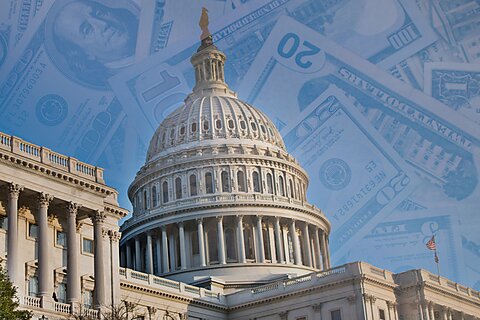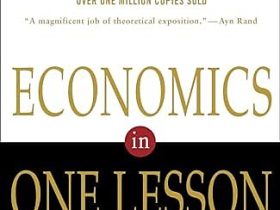Adam N. Michel
I would not have voted for the “One Big Beautiful Bill” that President Trump signed on July 4. The legislation adds trillions to the national debt, expands some of the worst tax subsidies, increases spending for parts of the government that are chronically overfunded, and includes many budget gimmicks. But it also does something Republicans haven’t had the courage to do in decades: it cuts spending below the prior-law baseline for programs previously thought untouchable: health care, food stamps, and green energy subsidies.
That alone makes it worth taking seriously, not as the silver bullet many boosters are claiming, but as narrow proof of concept for future reforms. Shrinking the federal government will be difficult and certainly won’t happen in one bill. If Republicans view these small cuts as successful, it will keep them from getting reversed and could lay the groundwork for more meaningful spending cuts in future packages.
A tremendous amount of ink has been spilled on the bill’s deficiencies, including by my colleagues (here, here, here, here, here, here, here, here, here, and here) and by me. I’d like to highlight the parts of the One Big Beautiful Bill that are worth celebrating and building on, even if they are imperfect (as most legislation is).
The Good Tax Policy Is Permanent—the Bad Is Temporary
The core critique of the bill from fiscal hawks is that it adds $3.4 trillion to the debt over ten years, and potentially more than $5 trillion if temporary provisions are extended. That’s because Congress cut taxes by $4 for every $1 in spending cuts as measured from the conventional Congressional Budget Office baseline. To actually address the deficit, Congress would have had to (and should have) cut spending more than it cut taxes.
Despite my many gripes with the tax package, it has at least two good structural features: the best provisions are permanent, and many of the worst are temporary.
The bill makes permanent key pro-growth reforms: full expensing for equipment and machinery, lower marginal income tax rates, and a larger estate tax exemption. These changes improve long-run incentives to work, save, and invest, helping to boost growth, a necessary (though not sufficient) ingredient in stabilizing the national debt-to-GDP ratio.
It also locks in several base-broadening and simplification provisions from 2017, including limits on itemized deductions and the consolidation of personal and dependent exemptions into the larger standard deduction and child tax credit. This avoids the sunset gimmicks that plagued the 2017 tax cuts and removes them from future negotiations.
In contrast, the expanded $40,000 state and local tax (SALT) deduction cap, the tax exclusion for tips and overtime, the additional senior deduction, the auto loan interest exclusion, and the Trump Account baby bonds are all set to expire after 2028. These provisions are poorly targeted, fiscally costly, and economically unjustified. They are temporary, which hides their fiscal cost but also makes them easier to eliminate in future negotiations, despite the omnipresent pressure to extend temporary tax breaks.
Spending Reforms: Limited but Real
While the bill doesn’t come within a light-year of balancing the budget, it does include $1.4 trillion in gross spending cuts over the next decade from the conventional baseline, measuring the total reductions before accounting for new spending elsewhere. The bill cuts $1.1 trillion in net spending. Add to that the half a trillion dollars in cuts to green energy tax subsidies (spending in the tax code), and the One Big Beautiful Bill could be tied for one of the largest spending cuts since the Tea Party era.
Notable spending reforms include changes to food stamps and Medicaid that return spending on those programs as a share of GDP to pre-Biden-era levels. Hardly a draconian cut, but progress nonetheless.
The individual policies are also worthwhile in their own right: stronger work requirements for able-bodied adults on food stamps and Medicaid, incentives for states to limit fraud in both programs, and modest limits on the “provider tax” scheme states use to unfairly inflate federal Medicaid payments to pad state budgets. Not included in the savings, Republicans allowed a $335 billion pandemic-era expansion of Obamacare subsidies to expire, despite vocal support for the policy from some in the conference.
The law also includes one of the largest reductions in corporate welfare in modern memory: repealing $500 billion (about half) of the Inflation Reduction Act energy subsidies. And a $300 billion reduction in education spending, including the long-overdue elimination of the destructive Grad PLUS program.
A Final Word of Caution
Let’s be clear: the One Big Beautiful Bill is neither fiscally ideal nor a positive step forward for all libertarian policy priorities. For example, it dramatically increases funding for Trump’s draconian immigration enforcement campaign and sets the stage for the first trillion-dollar Pentagon budget.
However, at the start of the year, many assumed Republicans couldn’t cut entitlement spending and taxes at the same time. The idea was too politically toxic. But history shows otherwise. Republicans cut spending on sensitive programs such as Social Security, Medicare, welfare, and food stamps in the 1980s and 1990s and won reelection. This bill follows that precedent. Despite razor-thin margins, Republicans passed a package that cut spending below the prior-law baseline and included permanent pro-growth tax reforms. That they included any spending reforms at all, especially in Trump’s Republican party, is noteworthy.
This bill alone won’t improve the trajectory of federal finances (it will almost certainly make it worse), but its many worthwhile reforms can lay the groundwork for more serious budget cuts in the future. Fiscal hawks should celebrate the wins in the bill. If we don’t defend the good reforms, future Congresses will continue to do what’s bad and politically easy.







